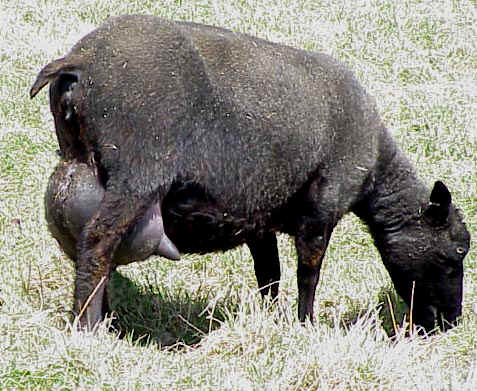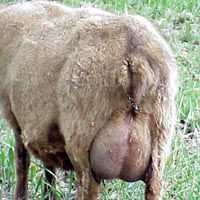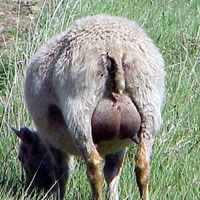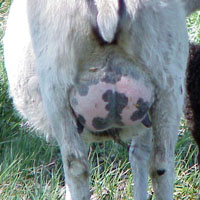Milking Icelandic Sheep

Icelandic Sheep have been used for the main dairy animal in Iceland and known as the poor mans cow for 1000 years. Not until the 1940’s did this change with the advent of mechanized haying in Iceland, which allowed enough hay to be harvested to use cows as the primary dairy animal. Up until that point in time all haying was done by hand. Haying season was very short and frequent rain was always a problem. Only rich farmers could afford to put up enough hay with hired labor to keep a cow. So the Icelandic sheep was the main dairy animal for most farms. The sheep were expected to winter over on the equivalent of 2 square hay bales, the fat on their backs and winter grazing when conditions were suitable
Lambing took place in May and June and was timed for warmer weather and the emergence of grass. Sometimes a ewe was milked out before she lambed and this watery fluid was used to make glue that was used in bookbinding, woodworking and made into glazes and ink. The first milk or colostrum was usually left for the lambs. If an excellent milker had more than her lamb needed then the colostrum was made into custard.
At 2 weeks of age the lambs started the weaning process by corralling the ewes in the evening about 6PM. The lambs were separated from the ewes and put in a separate shelter for the night and the ewes were again let out in the care of the shepherd to graze all night. In the morning at 6AM the ewes were corralled and milked out. After milking, the lambs and ewes were reunited to spend the day together.
This process went on for 4 to 6 weeks until the lambs were mature enough to be fully weaned. At this time the male lambs were castrated and driven up into the mountains or to inland common pastures along with the horses and other non-milking stock. The cows and ewes that were being milked were kept behind. The ewes were then milked 2 to 3 times a day and most gave a liter. Good milkers gave 2 or even 3 liters. The milk was used to make butter, cheese or skyr, which is a semi-soft cheese similar to thick yogurt mixed with cream cheese. The last milkings before the ewe was dried up was boiled down into a thick substance.
In some districts, the farmers would establish shelters at the upper reaches of valleys or on the edge of moors, which in essence were summer dairies. The usual set up included 3 buildings: a dwelling, a milk house and a summer kitchen. The shepherd, a milkmaid and a teenage girl who would help with the milking and cheese and butter-making occupied these shelters. These summer dairies were located near summer pastures and eliminated the need for long trekking to tend the stock. This also kept the stock away from the home pastures, which were used exclusively for hay production.
Today there is growing interest in establishing small farmer owned sheep dairies. The lucrative sheep cheese market in the USA has fueled interest in these specialty farm enterprises. Sheep milk is high in fat and dissolved solids which are what is needed to make excellent, high yielding cheese from relatively small amounts of milk.
Sheep milk is also being made into very profitable yogurt, which is velvety smooth, creamy and naturally sweet. It needs no sweetener or fruit to make it palatable. It is a desert quality dairy product.
The problem is to find excellent milking stock that is both hardy and has an excellent yield of milk for 180 days. Until now the leading milking sheep breed was the East Friesian which has been selected for high milk production. Unfortunately the breed is not hardy and the lambs are frail and have a low survival rate. The East Friesians also need inputs of grain in order to produce high milk yields. Since grain is the biggest cost in livestock raising, animals that need grain show lower profits. Icelandic sheep on the other hand are a hardy grass based breed that produces high yields of milk on grass alone. Animals that can thrive on forage alone bring higher profits to their shepherd. Icelandic sheep are reliable twinners and have vigorous lambs that thrive. In addition their fleeces bring top dollar as specialty wool. Their meat is known world wide as the best lamb for flavor, texture and tenderness.
If you want sheep that milk for dairy purposes for yourself, for a home business or to raise market lambs, try Icelandic. This is the low cost, hardy vigorous productive and profitable breed.
Here on the Tongue River Farm our lambs gain at the rate of three quarters to one pound a day on mothers milk and grass/clover alone. No grain is fed to the ewe or lambs. Growth this fast is the product of an excellent milk supply. We can supply milky breeding stock from a diverse pool of bloodlines some of which are from semen imported from Iceland and include the best sires from that country. This breed is milky and have udders that dairy folks can fully appreciate. Here are some photos of the business end of some of our milky ewes.


